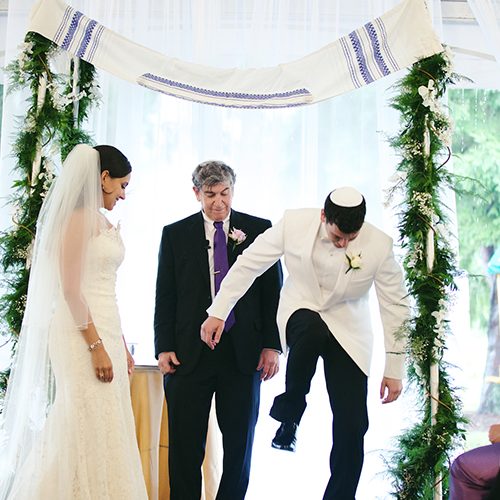
Photo: Lindsay Hite of Readyluck
Heading to your first Jewish wedding? Whether it’s reform or strictly orthodox, there are a few traditions that you will definitely see. Some may sound familiar, but knowing what to expect (and being versed in the meaning behind what you’re watching!) will make you even more prepared to celebrate. Our experts will take you through the five key components of a Jewish wedding.
Ketubah
The ketubah is a Jewish prenuptial agreement that outlines the groom’s responsibilities to his bride. It dictates the conditions he will provide in the marriage, the bride’s protections and rights, and the framework should the couple choose to divorce. Ketubahs aren’t actually religious documents, but are part of Jewish civil law — so there’s no mention of God blessing the union. The ketubah is signed by the couple and two witnesses before the ceremony takes place, then is read to the guests during the ceremony.
Chuppah
The chuppah is the altar beneath which the couple exchanges vows. A chuppah has four corners and a covered roof to symbolize the new home they are building together. In some ceremonies, the four posts of the chuppah are held up by friends or family members throughout the ceremony, supporting the life the couple is building together, while in other instances it may be a freestanding structure decorated with flowers. The canopy is often made of a tallit, or prayer shawl, belonging to a member of the couple or their families. You may see the couple’s parents join them under the chuppah, along with the rabbi, but this isn’t a requirement.
Seven Blessings
The seven blessings come from ancient teachings. They are often read in both Hebrew and English, and shared by a variety of family members or friends, just as friends and family are invited to perform readings in other types of ceremonies. The blessings focus on joy, celebration, and the power of love. They begin with the blessing over the wine, then progress to more grand and celebratory statements, ending with a blessing of joy, peace, companionship, and the opportunity for the bride and groom to rejoice together.
See more: What Do We Need to Tell Guests Before Our Religious Wedding Ceremony?
Breaking of the Glass
As the ceremony comes to an end, the groom (or in some instances the bride and groom) is invited to step on a glass inside a cloth bag to shatter it. The breaking of the glass holds multiple meanings. Some say it represents the destruction of the Temple in Jerusalem. Others say it demonstrates that marriage holds sorrow as well as joy and is a representation of the commitment to stand by one another even in hard times. The cloth holding the shards of glass is collected after the ceremony, and many couples choose to have it incorporated into some sort of memento of their wedding day.
Mazel Tov
Once the ceremony is over and the glass is broken, you will hear guests cheer “Mazel tov!”, which has a similar meaning “good luck” or “congratulations.” The direct translation is actually closer to wishing the best for the future, a great destiny, or a pronouncement that the person or people have just experienced great fortune. There’s no better time to say “mazel tov” than at a wedding!
